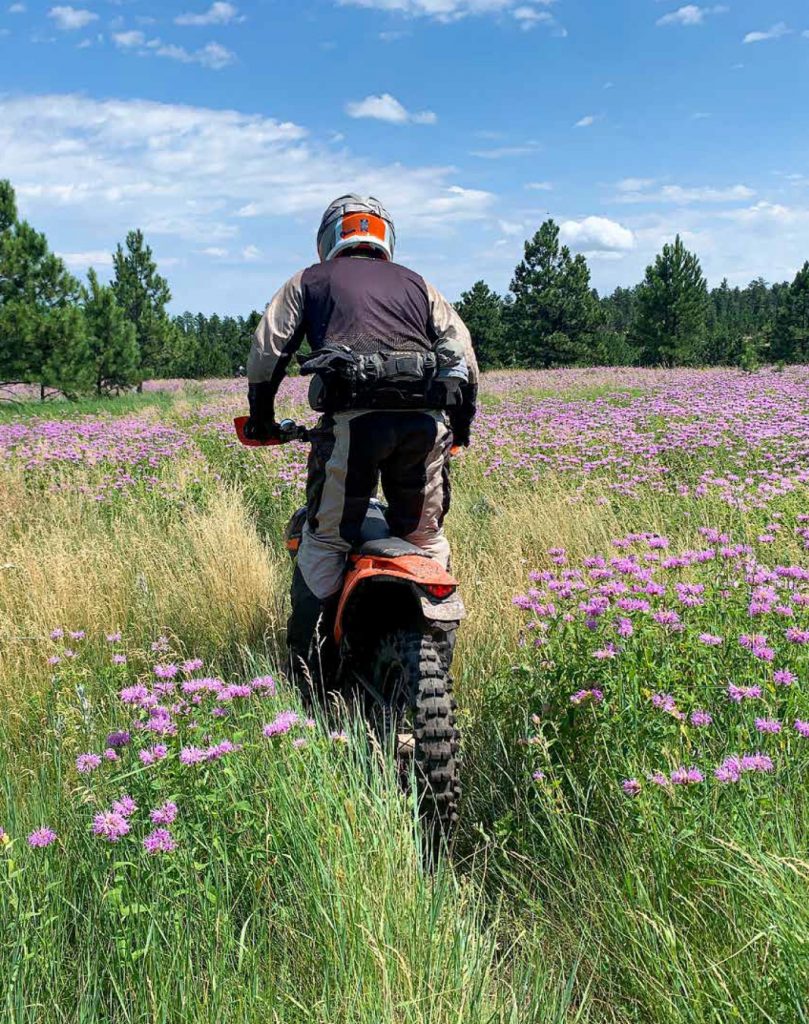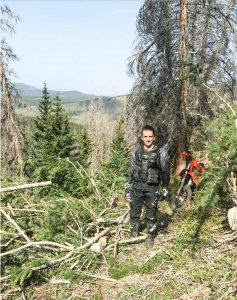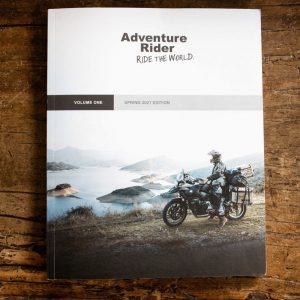Reposted with permission from Adventure Rider Magazine – December 2020
Ned Suesse is a member of the TPA Board of Directors
Access and Advocacy
The challenges faced when connecting beautiful places
Words & Images Ned Suesse
 Frequently, I’ve had conversations with friends on adventure bikes about public land management, and they fall to either side of a divide. One side holds that federal agencies are worthless and trying to close all of our access, and they therefore deserve to be either hated or ignored. The other side claims that the federal agencies are worthless and not doing enough to protect public lands, and groups like the Sierra Club are necessary to secure natural values.
Frequently, I’ve had conversations with friends on adventure bikes about public land management, and they fall to either side of a divide. One side holds that federal agencies are worthless and trying to close all of our access, and they therefore deserve to be either hated or ignored. The other side claims that the federal agencies are worthless and not doing enough to protect public lands, and groups like the Sierra Club are necessary to secure natural values.
In my view, neither of those stories has it right. In fact, we have an incredible bounty of great routes maintained by these agencies, so they deserve some credit. We also have great natural areas, and the laws that govern land use are generally biased to protect them. No matter what action or inaction the agencies choose, people will disagree, which explains how we can struggle to find consensus. Given that, I submit that the best way to improve the outcome for interesting routes that connect beautiful places, which we all enjoy riding, is a third idea: effective involvement to preserve and protect not only routes, but also the lands they pass through.
In the American West, most of our riding is on public land managed by one of two agencies: the Bureau of Land Management (BLM) or the Forest Service (USFS). These agencies operate under different rules, but both are governed by public process, which requires public engagement to achieve the best outcome. Neither agency is mandated or equipped to look at the popularity of their decisions, so effective engagement is rarely a matter of sending form letters. The place where popularity counts is the voting booth, specifically for members of Congress, the branch of government from which the agencies secure their funding. Your congressional representatives will have offices near you, and it isn’t hard to get a meeting with staff and explain what you think is important. They may not agree, but they will take note that you care.
In both the USFS and BLM, a great deal of control is delegated to the local offices, where there is a line officer who is generally equivalent to the captain of a ship. These people don’t control the armada, they don’t pick the overall direction, but the ship does not move without their consent. Therefore, effective engagement happens most often at a local level. In many areas, there are clubs that are doing this work, and you can join and donate time, energy and money to help them make a difference. Clubs are also where most on-the-ground work happens, from cleaning up trash, to clearing trees and building new trails. Often, clubs are run by exhausted volunteers on the verge of quitting, so joining and helping can make a huge difference as well as providing new riding buddies.
The public servants who work in these agencies are generally bureaucrats who have worked their way up through a system that does not reward the same qualities private industry does. In many cases, these bureaucrats are pleasant, reasonable folk, which doesn’t necessarily mean they understand or appreciate the existence of motorcycle riders on their public land. It is our job to justify ourselves, and our use, to people who are unaware or maybe even biased against us. It may not be obvious to a non-motorcyclist that connections and campsites are important to us. We can help them see the world our way.
These land managers are tasked with managing our lands within a mess of laws that are difficult for the layperson to understand and often contradictory even when one does. The rule that comes up most often is the National Environmental Policy Act (referred to as “NEPA”) which sets a process for every decision the federal government makes that affects the quality of the environment. The NEPA process has different protocols depending on the potential impact of the decision, but the key thing to understand is that decisions are made in a process, and there are times in that process where you can comment and be involved, and times where you cannot. Generally, during the “scoping period,” you can get involved. Later, once scoping is past and comment periods close, nothing you say has any effect, no matter how correct you might be. Scoping and comment is required for all NEPA processes, and most offices have a process to get you subscribed to notices so that you can be involved at the appropriate time.
 The other key rule that affects our use is Travel Management. This is done at a broader level than decisions, typically by a Forest (USFS) or a Field office (BLM). As with everything else, there is a defined process to be involved with, and effective engagement requires getting involved early. Travel Management may only happen every decade or two, so when it comes along it is critical to be involved with it. Because Travel Management encompasses a larger area, often a statewide organization will be involved. These statewide organizations serve an important role alongside clubs. Where a club is more likely to make a difference on the ground, the statewide groups are able to bring legal pressure, expert testimony and policy experts to bear on the larger regional issues.
The other key rule that affects our use is Travel Management. This is done at a broader level than decisions, typically by a Forest (USFS) or a Field office (BLM). As with everything else, there is a defined process to be involved with, and effective engagement requires getting involved early. Travel Management may only happen every decade or two, so when it comes along it is critical to be involved with it. Because Travel Management encompasses a larger area, often a statewide organization will be involved. These statewide organizations serve an important role alongside clubs. Where a club is more likely to make a difference on the ground, the statewide groups are able to bring legal pressure, expert testimony and policy experts to bear on the larger regional issues.
Personally, I was uninterested in any of this until my favorite place to ride was closed. I went from uninterested to really angry in a flash, and it has taken decades to work my way back to engaged. Everything that happens on public land happens at the speed of government, which is both frustrating and occasionally beneficial, since bad news can happen as slowly as good news does. If you are getting involved, recognize that advocacy requires slow and steady involvement, not just a few moments of your time. It takes hydraulic pressure, not hammer blows. If you want to make a difference, show up, join a club, donate, get to know your local agency people and expect that moving the needle will take months and years, not days or weeks.
In the end, I see a false division between “environmentalist” and “motorcyclist”. I don’t know a single rider who would prefer an unhealthy forest to a thriving one, and in many areas, most of the trail work and funding to maintain trails comes from off-highway vehicle riders. This leads to the final point: wherever possible, we can try to break down the perception of us (motorcyclists) vs. them (environmentalists). Enviromotorist is a viable position (not to be confused with moto-mentalists) that holds that responsible access can coexist with maintaining natural values. Motorcyclists will never win a popularity contest, but we can show how our position is compatible with others.
Wilderness
- Wilderness (capital W) is defined by congress and allows no mechanized recreation, including bicycles, motorcycles, hang gliders and so on. It is the most restrictive protection available. Many companies talk about riding in wilderness (small w), so keeping the legal definition in mind is important.
- Wilderness does not allow for fire mitigation (exceptions are made for fires once burning), or management for species of concern. Trail maintenance must be done by hand (no chainsaws).
- You can support existing Wilderness, but be against additional Wilderness. This is my position. The places that are “untrammeled by man” as congress defined are largely already designated. New designations focus increasing use on diminishing areas and abdicate responsibility for management.
Success Story
- In Salida, Colorado, the Central Colorado Mountain Riders (CCMR, local club), with support from the Colorado TPA (state organization) have succeeded in adopting, maintaining and even opening several new trails over the last few years.
- Each action has taken years to complete, and required partnerships with non-OHV groups for success. CCMR has an active board of volunteers who each take ownership of individual projects.
- Latest example: In 2020, Dudbob’s trail was constructed and opened on BLM. The process for this trail started in approximately 2015.
Things You Can Do
- Be a steward—take care of the roads and trails you use, help educate other users, and leave campsites better than you found them.
- Be an ambassador—show the best of motorcycling to other users, businesses that you patronize, and people who work in the land management agencies.
- Get involved locally—join your local club and show up for work days and public process meetings.
- Donate funds—send money to organizations not only where you live, but also where you want to ride.
About Adventure Rider
ADVrider was launched in 2001 to provide adventure motorcycle riders their own dedicated online community. The site was debuted as an adventure riding forum and has grown to become the most visited website in the world for motorcycle enthusiasts. ADVrider currently has over 350,000 registered members who have submitted 33 million original posts.

